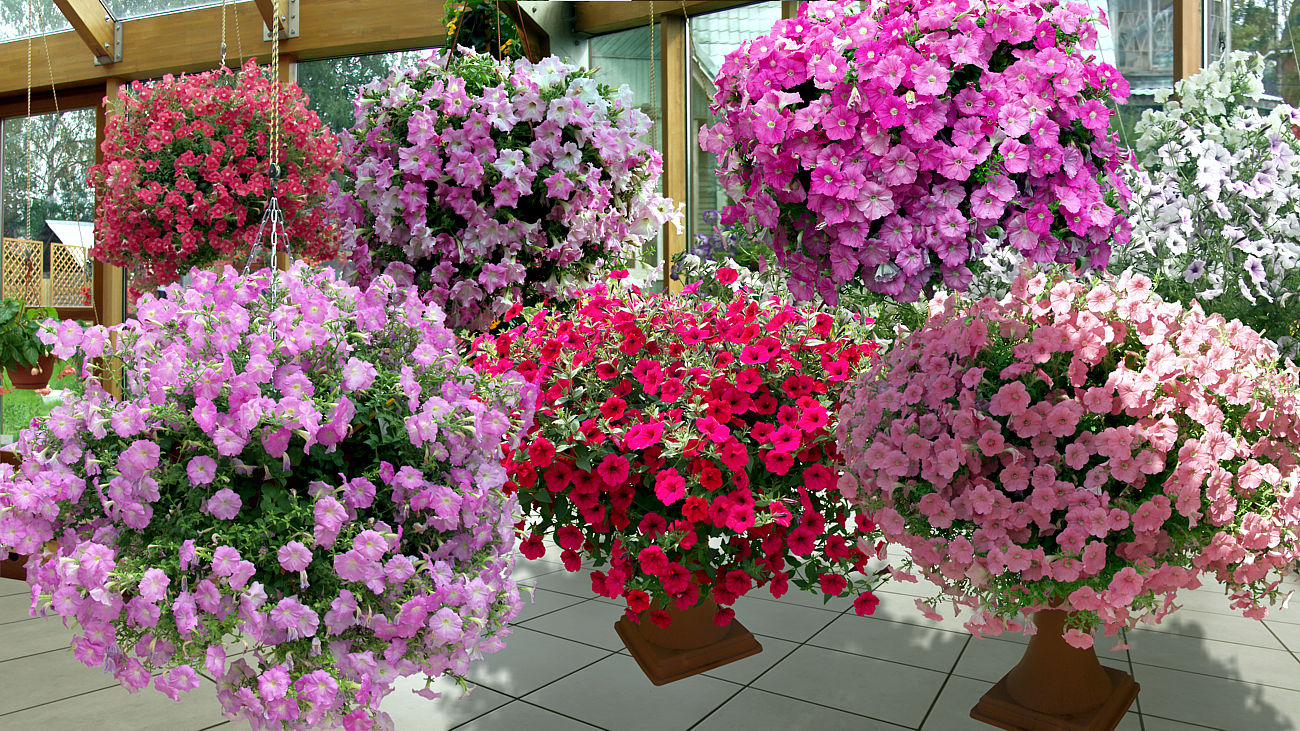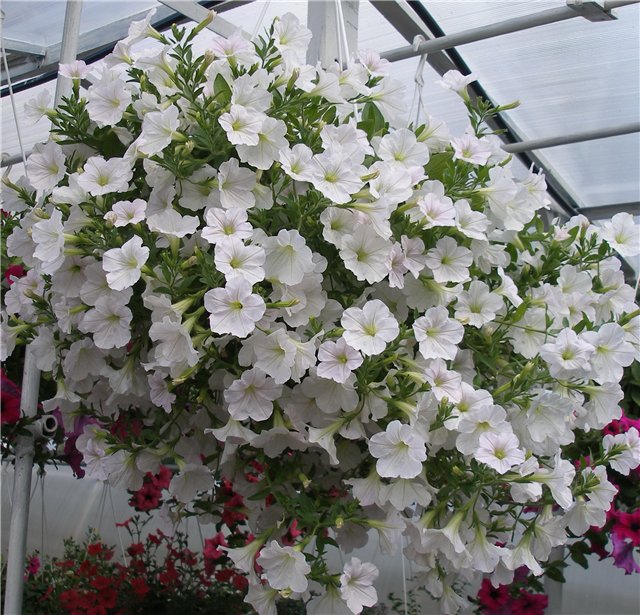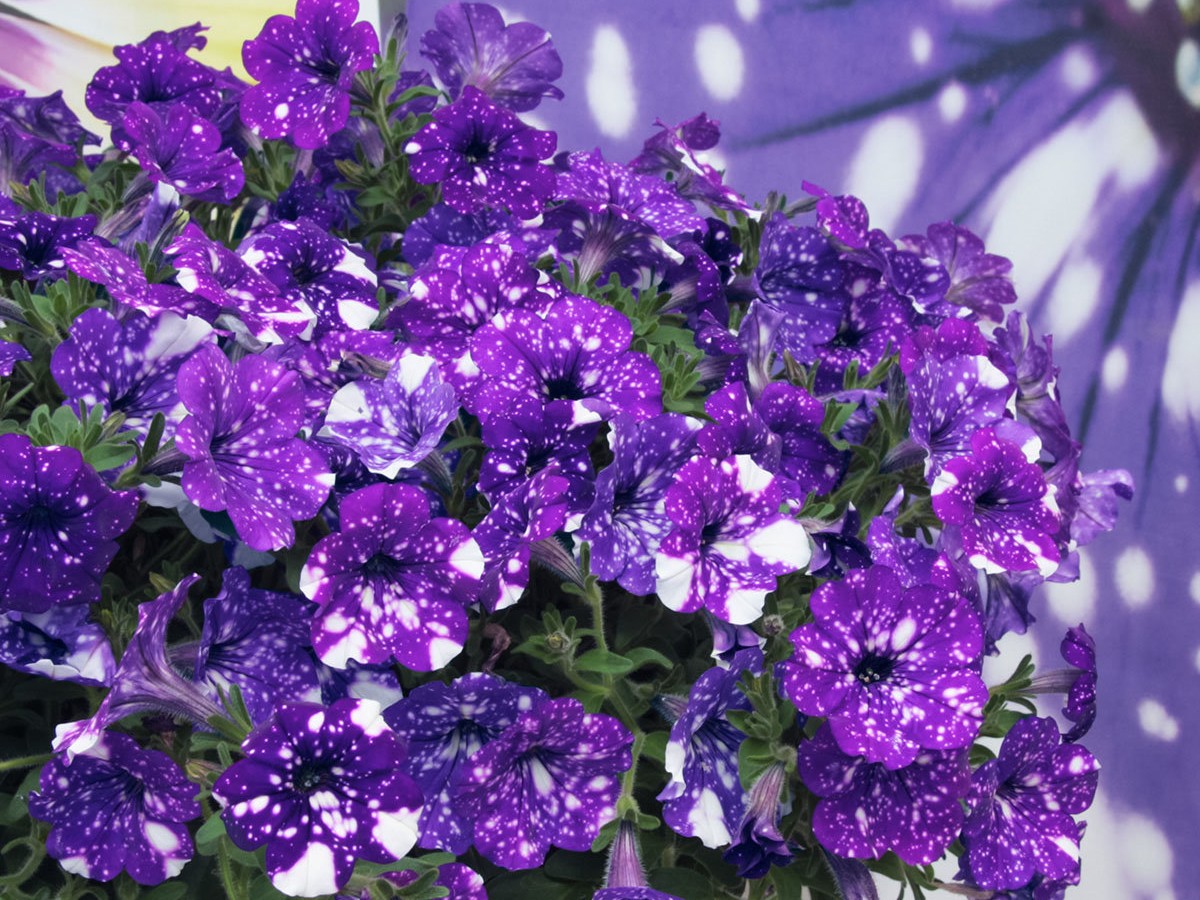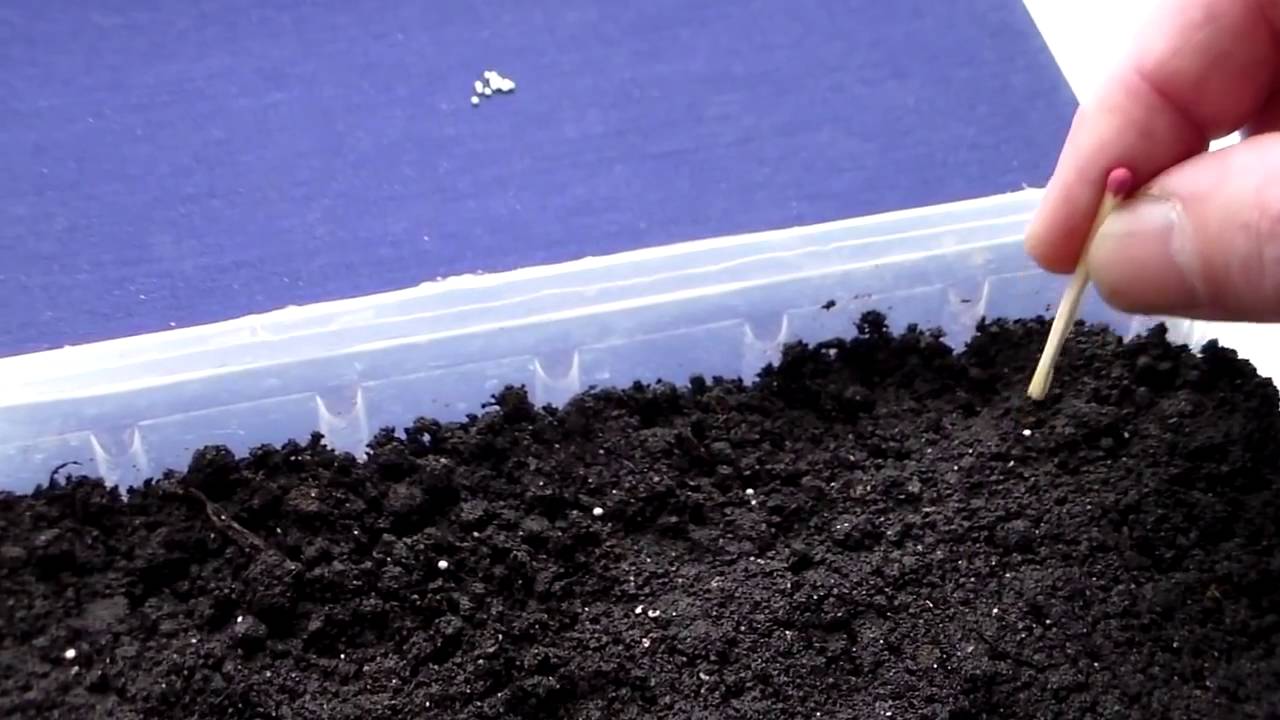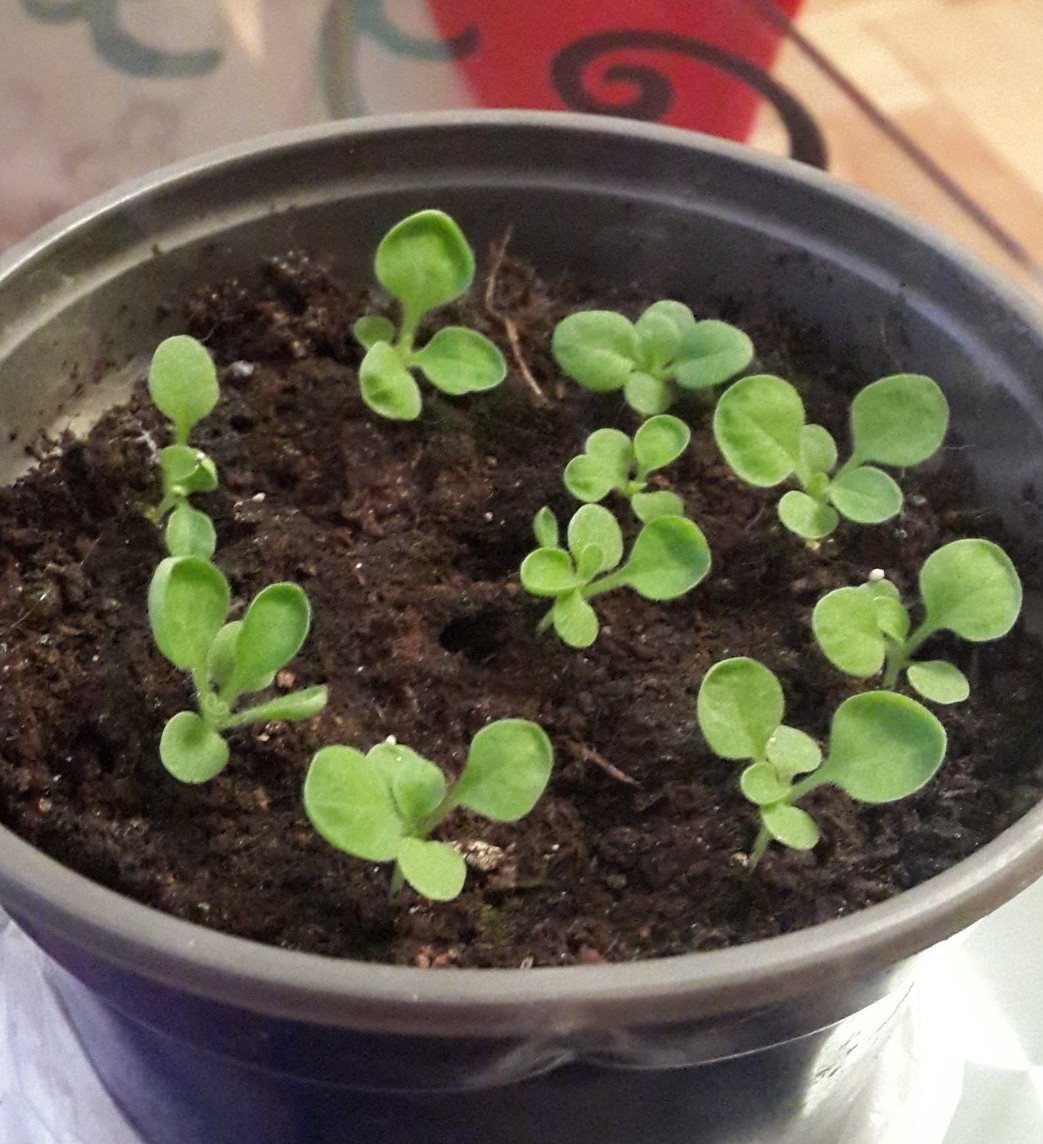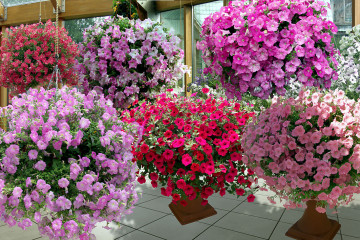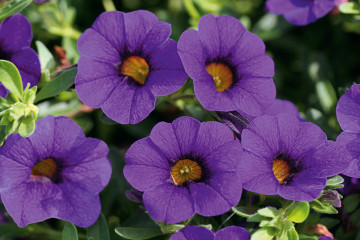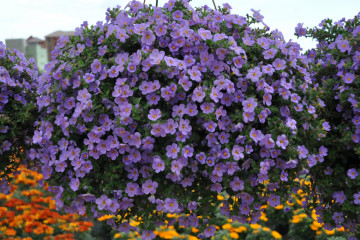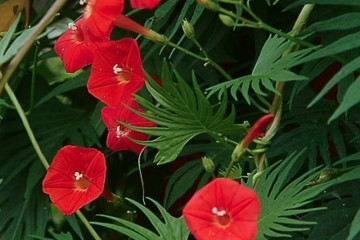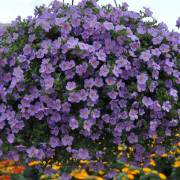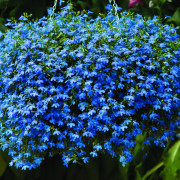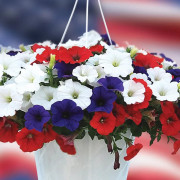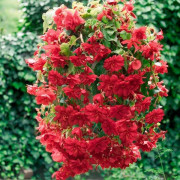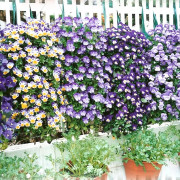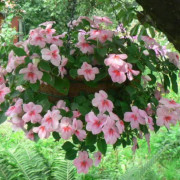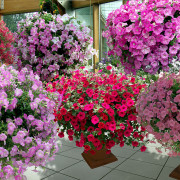Petunia ampelous - annual or perennial
Content:
Petunia ampelous is an annual herb with creeping shoots of 30-120 cm. Leaves are oval, lanceolate. Hairy shoots. Funnel-shaped flowers are located in the axils of the leaves along the entire length of the stem. Petals are simple or double. The color of the corolla can be monochromatic or multi-colored. The color range is from snow-white to deep purple shades. Corolla size from dwarf forms up to 10 cm in diameter. On multi-flowered varieties, the size of the buds is up to 8 cm, 4-5 stamens. The fruit is a bivalve capsule. The seeds are small. The easiest way to grow it.
Growing ampelous petunia
Petunia is easy to select. Therefore, at present, a large number of its varieties and species have been bred, which is constantly being replenished.
In addition to the color of the corolla, plants are also divided according to the type of flower into double or with a double edge and simple. Terry petunia has more petals than ordinary petunia. This gives the flowers splendor, airiness and makes them more noticeable. Terry is inherent in varieties of the hybrid type. In addition, there are small-flowered ampelous petunias and large-flowered ones.
Small-flowered are undemanding in care, do not need feeding, can grow almost anywhere. Their variety is as great as that of plants with large flowers.
By the nature of growth, plants are classified as erect or ampelous. Ampel varieties are widely used as landscaping and decoration of balconies, terraces, containers. They are also planted in flower beds, where petunias are able to decorate a large area or hide bare areas of land.
Popular varieties
In Russia, the following flower varieties are most popular.
Easy Wave
Translated from English "light wave". The variety was bred in the USA. This is an unpretentious plant that has a rich and long flowering almost all summer. Flowers 7 cm in diameter with a faint aroma. Easy Wave rises 20-30 cm above the ground and then falls down to a meter length.
Variety subspecies:
- shoots of Easy Burgundy, with two-colored corollas, reach 2 m;
- Yellow looks relatively compact. It is a spherical bush with yellow-white flowers;
- Red Velor blooms with red velvet flowers with dark veins on the petals, black center;
- Palm Wayne has a lavender bud color.
Opera
Unpretentious in care, has a well-developed branching at the base of the shoot. Flowers 5-6 cm, located along the length of the entire stem. The scourge grows up to 100 cm. In a hanging basket it is most often spherical, dense.
Other subspecies:
- Terry corollas of Blue variety are painted in bright blue. Long flowering period;
- Parple is distinguished by numerous purple, violet-crimson flowers;
- Coral in adulthood takes on the shape of a dome. Blooms in coral colors;
- White is famous for the snow-white color of the petals, which delight the eye for 5 months.
Rapunzel
This plant is up to 80 cm long.At a young age, the shoots are erect, but in the process of growth they begin to hang down. Over time, a spreading cascade of red or white grows. The diameter of the corolla with simple petals is up to 8 cm. Flowering from June to early autumn.
Success
Translated from English means "success". The size of the lashes is on average 70 cm. Early large flowers appear in large numbers together. Flowering takes place evenly. The flower is resistant to bad weather.
Avalanche
This is an early flowering petunia with giant flowers up to 10 cm in size. The stems grow up to 45-50 cm. The shoots are thin with small leaves. Ampelous petunia is popular Avalanche white. During flowering, its snow-white corollas with a yellow center densely cover the stems. The plant is not demanding to care for. The flowering period of white ampelous petunia is from early summer to mid-autumn. Another variety of the variety is Avalanche purple. Peduncles are colored lilac-purple with a darker core.
Craisitunia Mandeville
Belongs to the Crazyunium series. Differs in a spherical shape and a special color of flowers. The petals are velvety dark red with a yellow vein. The shape of the corolla resembles a lily. It begins to bloom in May so abundantly that the greenery is practically invisible. Compared to most other ampel varieties, the bush looks taller (up to 40 cm) and more dense.
Starry sky
This novelty was developed by German breeders in 2015. Scourges grow up to 1 m and branch strongly. Long flowering. The name of the variety conveys exactly what its flowers look like. Corollas are painted in an intense blue-violet color, on which white specks are sprinkled like stars. Flowers have a corduroy texture. This coloration is very similar to space. Despite its recent origin, this variety has already become very popular among flower growers.
Big Time ampelous
A compact shrub with lush blooming pink buds from simple petals. The plant is characterized by a fairly good endurance. Unlike many of its relatives, it has small shoots. As a result of branching, it forms a spherical shape.
Sowing seeds
In temperate climates, it is better to plant petunias in open ground with seedlings. Then growth will be faster.
Sowing dates
The development time of the plant from the sowing period to the flowering period is on average about 3 months. In temperate climates, backlighting is desirable for the first time so that the seedlings do not stretch out and do not weaken. This is usually mid-February - early March.
For landing you will need:
- seeds;
- soil;
- containers for planting;
- scoop, tweezers (the one for lenses is convenient);
- sprayer%
- water.
The soil
The soil should be light, neutral acidity, nutritious. You can make up the soil yourself. This will require sod land, peat, coarse sand. Stores sell ready-made soil suitable for petunias, for example, ready-made mixture for violets.
The container or cup should have a hole to drain off excess water. Otherwise, the seedling will die.
Sowing
Sowing stages:
- Expanded clay is placed on the bottom of the container.
- Then a layer of soil. It should be crushed a little. It is better not to pour the soil to the very top of the pot, otherwise it will be inconvenient to water.
- The substrate is moistened with a spray bottle.
- Use tweezers to distribute seeds in containers.
- The planting material is slightly crumpled.
- All are sprayed.
- The top is covered with a glass lid or plastic bag.
- Sign the sowing date. Better not with a pen, it can wear off over time.
After planting, the containers are placed in a room with a temperature of about 25 ° C.
Many gardeners use peat tablets. One granular seed or two ordinary seeds are placed in the soaked tablet. When transplanting seedlings, seedlings with a ready-made root system are used without removing the pill.
When sowing seeds in open ground, a place for a flower garden is dug up, complex fertilizer is added. Then they sow seeds mixed with sand.
Many gardeners prefer to buy ready-made seedlings.
Further care
The sprouts begin to sprout in about a week. During this time, the container should be ventilated for 20-30 minutes. in a day. When seedlings appear, you can start airing twice a day.
It should be borne in mind that seeds of different varieties of petunias can sprout at different times. It is necessary to read the instructions in advance, which are usually written on the packaging.
When caring for seedlings, the following conditions must be observed:
- follow the light regime, but shade from direct sunlight;
- observe that the soil is always slightly moist. Sprinkle gently with water at room temperature;
- ventilate. At this time, you can spray;
- for hardening, it is enough to take out the boxes with seedlings on the street for 20-30 minutes;
- remove condensate on the container lid.
When the seedlings have three leaves, they are seated in separate containers. It is advisable to do this with a small lump of soil around the roots to avoid injury. To relieve stress during transplantation and better growth afterwards, you can treat petunias with a biological product HB-101 or epin.
At this time, the air temperature is gradually reduced to 18 ° C. Watering is reduced to a slight drying out of the top layer of the soil. Airing is gradually increased, thus hardening the seedlings. The soil is loosened carefully so that a crust does not form. The container is periodically unrolled so that the plant develops correctly and does not turn out to be one-sided.
Open ground transplant
Grown up ampelous petunias are planted outside after all spring frosts have passed. The transplant is carried out on a cloudy day so that the seedlings do not burn. Before this, the clod of earth is slightly dried. Then it will be easier to remove from the container. After the seedling was taken out of the container, trying not to damage the roots, the plant is transferred to the prepared hole, covered with earth and the soil is slightly tamped around the shoot. The distance between the seedlings of large-flowered petunias is observed at 20-25 cm. Small-flowered ones are planted 15-20 cm apart.
If you want to plant several flowers in a container, then first they are distributed in the hole, and then the gaps are covered with soil. In this case, it is expected that 1 liter of soil falls on one root.
After transplanting, a thin layer of peat, last year's humus or sawdust is added, thus preventing the soil from drying out quickly and crusting.
Most petunias prefer sun or light partial shade, open area. But, when planting young plants in open ground, they should be protected from the scorching sun for some time.For this purpose, use spandex or gauze folded 2-3 times.
Open ground is different from seedling substrate. It should be sandy loam soil, heavier, and lower drainage than at home.
10 days after transplanting to the street, ampelous petunias begin to feed. For this purpose, fertilizers with a high nitrogen content are used. Then the plants grow better during the growing season. Three weeks after transplanting, they switch to feeding for flowering plants. These fertilizers contain a large amount of potassium. It promotes the budding process, that is, more lush flowering.
Reasons why petunias do not bloom
For lush flowering, it is not enough to plant plants in time. There are a number of reasons why petunias feel bad:
- imbalance of nutrients. You should carefully read the instructions for use of fertilizers. It is better not to add a little than to overdo it;
- if the shoots have a dull, thinned appearance, then, most likely, there is not enough sunlight;
- improper watering can also cause the buds to drop.
When choosing a plant, you should take into account the style and interior design, as well as pay attention to the color scheme. There can be several varieties in one container. Other types of flowers may also coexist, for example, fern, lobelia, hosta.
As a result of all this information, it becomes clear that ampelous petunias are quite unpretentious flowers that are distinguished by long flowering. There is a large selection in varieties and varieties. This plant can be grown not only by professionals, but also by beginners in gardening.
